|
Featured picture tools: |
These featured pictures, as scheduled below, appeared as the picture of the day (POTD) on the English Wikipedia's Main Page in November 2010. Individual sections for each day on this page can be linked to with the day number as the anchor name (e.g. [[Wikipedia:Picture of the day/November 2010#1]] for November 1).
You can add an automatically updating POTD template to your user page using {{Pic of the day}} (version with blurb) or {{POTD}} (version without blurb). For instructions on how to make custom POTD layouts, see Wikipedia:Picture of the day.Purge server cache
November 1

|
The Tasmanian Native-hen (Gallinula mortierii) is a flightless rail, one of twelve species of birds endemic to the Australian island of Tasmania, except the southwestern portion. Although flightless, it is capable of running quickly and has been recorded running at speeds up to 30 miles per hour (48 km/h). Fossil records indicate that the Tasmanian Native-hen was found on the Australian mainland until around 4700 years ago. Suggested reasons for its extinction there have included the introduction of the dingo, or an extremely dry period. Photo: Noodle snacks
Recently featured:
|
November 2
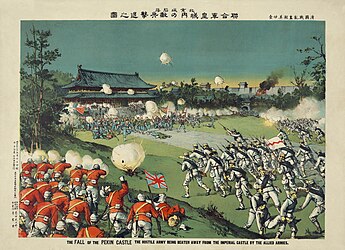
|
Japanese and British troops attack members of the Society of Righteous and Harmonious Fists ("Boxers") at Beijing Castle during the Boxer Rebellion of 1899–1901. The Boxers, angered by foreign imperialist expansion into Qing Dynasty China, had engaged in looting, arson, and killings of foreigners. In 1900, the Empress Dowager Cixi employed the Boxers to attack foreign settlements in Beijing. The uprising was eventually put down by 20,000 troops from the Eight-Nation Alliance. Artist: Kasai Torajirō; Restoration: Staxringold
Recently featured:
|
November 3

|
A Grass Skipper butterfly from the genus Pelopidas. With over 2,000 described species, Grass Skippers are the largest subfamily of Skippers, which are named after their quick, darting flight habits. Photo: Muhammad Mahdi Karim
Recently featured:
|
November 4

|
The giant Suttungr threatens some dwarves, in this scene from Norse mythology. In the story, the dwarf brothers Fjalar and Galar had murdered Suttungr's parents. The giant captured the two, as well as some other dwarves, and placed them on a rock that would be submerged by the tide (shown here). The dwarves begged for Suttungr to spare their lives and offered him the magical mead of poetry, which would allow whoever drinks it to have the ability to recite any information and solve any question. The mead was then stolen by Odin and given to the gods and to men gifted in poetry. Artist: Louis Huard; Restoration: Adam Cuerden
Recently featured:
|
November 5
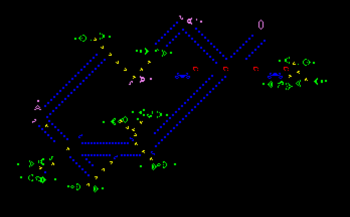
|
An animated image from Conway's Game of Life showing oscillators of varying periods that double as glider reflectors (highlighted in pink), which are patterns that can interact with a spaceship to change its direction of motion, without damage to the reflector patterns themselves. Image: Simpsons contributor
Recently featured:
|
November 6
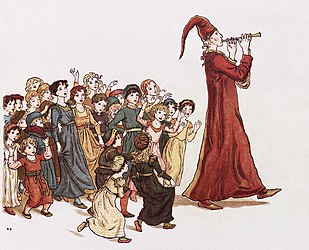
|
An illustration by Kate Greenaway that accompanied Robert Browning's version of the Pied Piper of Hamelin, a legend wherein a piper is hired by the town of Hamelin, Germany, to lead rats away with his magic pipe. The town refuses to pay his wages and he retaliates by leading the children of the town away as well. Restoration: Lise Broer
Recently featured:
|
November 7

|
Clavulinopsis corallinorosacea is a species of coral fungus, so named for their resemblance to aquatic coral. Coral fungi can be similar in appearance to jelly fungi. They are often brightly colored, mostly oranges, yellows, or reds, and usually grow in older mature forests. Some coral fungi are saprotrophic on decaying wood, while others are commensal or even parasitic. Photo: Noodle snacks
Recently featured:
|
November 8

|
A traditional hut of the Chaga people, Bantu-speaking indigenous Africans who live on the southern and eastern slopes of Mount Kilimanjaro and Mount Meru, as well as in the Moshi area. In agricultural exports, the Chaga are best known for their Arabica coffee, which is exported to American and European markets, resulting in coffee being a primary cash crop. Photo: Muhammad Mahdi Karim
Recently featured:
|
November 9

|
The Little Pied Cormorant (Microcarbo melanoleucos, shown here in wing-drying pose) is a common Australasian waterbird. It is a small short-billed cormorant, measuring 56–58 cm (22–23 in) in length, usually coloured black above and white below with a yellow bill and small crest. Photo: Noodle snacks
Recently featured:
|
November 10

|
The fruit of an alpine pasqueflower (Pulsatilla alpina), an alpine plant found in the mountain ranges of central and southern Europe from central Spain to Croatia. It grows between 1,200 and 2,700 m (3,900 and 8,900 ft) above mean sea level and is mildly toxic. A number of subspecies are recognised, based largely on the form and hairiness of the leaves. Photo: SiameseTurtle
Recently featured:
|
November 11

|
A poster from Wales advertising a fundraising event to support Welsh troops in the First World War. The United Kingdom during this period underwent a number of societal changes, mainly due to wartime events: many of the class barriers of Edwardian England were diminished, women were drawn into mainstream employment and were granted suffrage as a result, and increased national sentiment helped to fuel the break up of the British Empire. Artist: Frank Brangwyn; Restoration: Lise Broer
Recently featured:
|
November 12
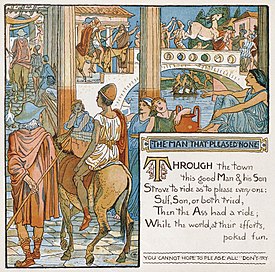
|
"The Man That Pleased None", from Walter Crane's 1887 illustrated book The Baby's Own Aesop, a collection of Aesop's Fables retold in limerick format. Aesop lived in Ancient Greece between 620 and 560 BCE, and his fables are some of the most well known in the world, remaining a popular choice for moral education of children today. Crane, a member of the Arts and Crafts movement, popularised the child-in-the-garden motifs that would characterise many nursery rhymes and children's stories for decades to come. Restoration: Lise Broer
Recently featured:
|
November 13
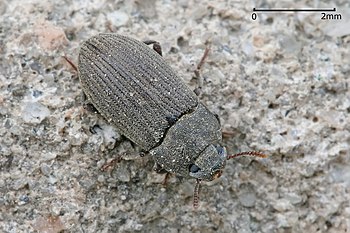
|
An Alphitobius species of darkling beetle, a large family of beetles found worldwide, containing more than 20,000 species. The larval stages of several species are cultured as feeder insects for captive insectivores, and include the very commonly known mealworms and superworms. Photo: Muhammad Mahdi Karim
Recently featured:
|
November 14
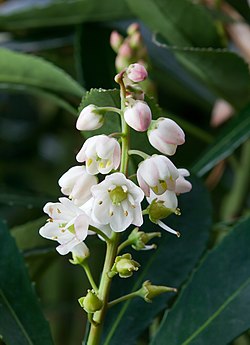
|
Anopterus glandulosus (Native Laurel or Tasmanian Laurel) is a species of shrub or small tree in the family Escalloniaceae, native to Tasmania in Australia. It usually occurs as a shrub 2-4 metres high but may occasionally form a tree up to 10m high. The leaves are large, 7–17 cm long and 2–4 cm wide. The white to light pink flowers are about 2 cm across and occur during spring and often again in autumn. Photo: Noodle snacks
Recently featured:
|
November 15
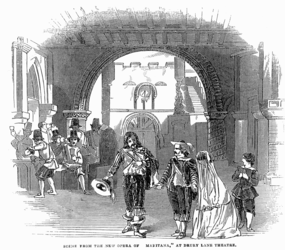
|
Maritana is an opera first produced at the Theatre Royal, Drury Lane on 15 November 1845, conducted by its composer, William Vincent Wallace. The opera is in three acts and is based on the play Don César de Bazan by Adolphe d'Ennery and Philippe François Pinel Dumanoir (1806–1865). Image: The Illustrated London News
Recently featured:
|
November 16

|
The Low Memorial Library rotunda of Columbia University, an Ivy League university in New York City, c. 1900–10. The building no longer serves as a library, having been converted to administrative purposes when it was supplanted by the larger Butler Library in 1934. However, the building's facade is still etched with the words "The Library of Columbia University," leading many to mistakenly believe that it retains its earlier role. The building was designed in the neoclassical style by the architectural firm of McKim, Mead, and White, which was responsible for the design of much of the campus. It is registered as a National Historic Landmark. Photo: Detroit Publishing Co.; Restoration: Lise Broer
Recently featured:
|
November 17

|
The platform at Clapham Common, a station on London Underground's Northern line. With tracks on either side serving trains moving in opposite directions, this is an example of an island platform. This configuration is popular in the modern railway world, but may present engineering challenges to existing rail lines. Photo: David Iliff
Recently featured:
|
November 18
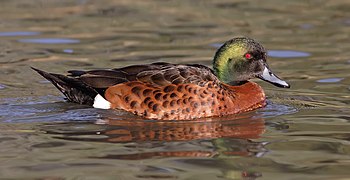
|
The Chestnut Teal (Anas castanea, male shown here) is an omnivorous dabbling duck found in southern Australia. The male has a distinctive green coloured head and mottled brown body. The female has a brown head and mottled brown body, which is almost identical to a female Grey Teal. Photo: Fir0002
Recently featured:
|
November 19

|
In the poem "The Queen of Hearts", the titular queen bakes some tarts, which are then stolen by the Knave of Hearts (shown here). The King of Hearts has the Knave punished, so he brings them back and pledges not to steal again. The poem was published anonymously in 1782, along with three lesser-known stanzas, all about characters based on playing cards. Artist: W. W. Denslow; Restoration: Lise Broer
Recently featured:
|
November 20

|
This photo of the International Space Station (ISS) was taken during STS-119, a Space Shuttle mission that delivered and assembled the fourth starboard Integrated Truss Segment, and the final set of solar arrays and batteries to the station. Construction of the ISS is still ongoing and is scheduled to complete in December 2011. Photo: NASA
Recently featured:
|
November 21
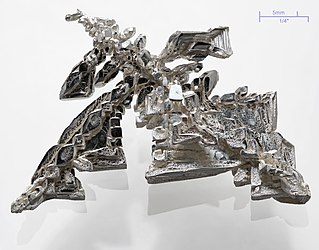
|
A specimen of crystallized silver, electrolytically refined, with dendritic structures. On metals, dendrites are tree-like structures formed as molten metal solidifies. This dendritic growth has large consequences in regards to material properties. For example, smaller dendrites generally lead to higher ductility of the product. Photo: Alchemist-hp
Recently featured:
|
November 22
|
A panorama of Beirut in the late 19th century under Ottoman rule. After the collapse of the Ottoman Empire following World War I, Beirut, along with the rest of Lebanon, was placed under the French Mandate. After Lebanon achieved independence on 22 November 1943, Beirut became its capital city. Photos: Maison Bonfils; Restoration: Banzoo
Recently featured:
|
November 23
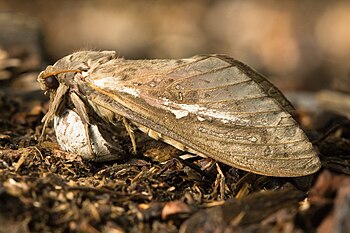
|
The Pindi moth (Abantiades latipennis) is endemic to Australia, where the larvae primarily feed on the roots of Eucalyptus trees. Female moths "lay" their eggs by scattering up to 10,000 of them during flight. Larvae then hatch in the leaf litter on the forest floor and begin tunnelling in search of suitable host roots. Photo: Noodle snacks
Recently featured:
|
November 24

|
A scene from Chapter XXVII of Guy Mannering, a historical novel by Sir Walter Scott that was originally published anonymously in 1815. It is set in the 1760s to 1780s, mostly in the Galloway area of southwest Scotland. The eponymous character of Guy Mannering is actually only a minor character in the story, the plot being mostly concerned with Harry Bertram, the son of the Laird of Ellangowan, who is kidnapped at the age of five by smugglers. It follows the fortunes and adventures of Harry and his family in subsequent years, and the struggle over the inheritance of Ellangowan. The novel also depicts the lawlessness that existed at the time, when smugglers operated along the coast and thieves frequented the country roads. The book was a huge success, selling out the day after its first edition. Artist: Norman Mills Price; Restoration: Adam Cuerden
Recently featured:
|
November 25

|
The fruit of Leptecophylla juniperina, a flowering plant native to New Zealand and southeastern Australia. In New Zealand, it is known as Prickly Heath and Prickly Mingimingi, and one subspecies in Tasmania is called Pink Mountain Berry. The plants grow best in areas with moderate winters and cool moist summers, and the fruit is edible. Photo: Noodle snacks
Recently featured:
|
November 26
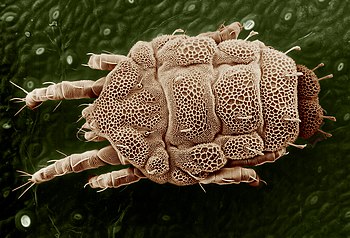
|
A digitally colorized scanning electron micrograph of a yellow mite (Lorryia formosa), a common agricultural pest of citrus trees around the world. The magnification in this image is approximately 200x, as specimens are generally less than 250 µm long. Image: Eric Erbe/Chris Pooley, ARS
Recently featured:
|
November 27

|
A shaggy parasol mushroom, with its cap not yet opened. The common name applies to two closely related species, Chlorophyllum rhacodes and C. brunneum, both of which are found in North America and Europe, with the latter species also present in Australia. The stem typically grows to 10 to 20 cm (4–8 in) tall, and the cap grows to 7.5 to 20 cm (3–8 in) across. Shaggy parasols are edible, but are very similar in appearance to the poisonous Chlorophyllum molybdites. Because the two can only be reliably identified by spore print, they are not recommended for inexperienced hunters. Photo: Jörg Hempel
Recently featured:
|
November 28

|
The Musk Lorikeet (Glossopsitta concinna) is a species of lorikeet found in south-central/eastern Australia. It grows to about 22 cm (9 in) long, and can be identified by its red forehead, blue crown and a distinctive yellow band on its wing. Photo: Fir0002
Recently featured:
|
November 29

|
Three specimens of blue mussel (Mytilus edulis), a medium-sized edible marine bivalve mollusc. Blue mussels live in intertidal areas around the world, attached to rocks and other hard substrates by strong (and somewhat elastic) thread-like structures called byssal threads. They are commonly harvested as food in many different cuisines. In the upper left, the mussel is closed. The upper right shows the mussel slightly open, with the white posterior adductor muscle visible. Lastly, in the bottom individual, the adductor muscle has been cut to allow the valves to open fully. Photo: Rainer Zenz
Recently featured:
|
November 30

|
A photochrom print of Royal Avenue in Belfast, Northern Ireland, from the 1890s. In the 19th century, Belfast became Ireland's pre-eminent industrial city, and saw an influx of immigration, made up of mostly Catholics into a predominantly Protestant city. Sectarian tensions remained high throughout the years, with no major incidents having taken place since 1998's Belfast Agreement. Image: Detroit Publishing Co.; Restoration: Lise Broer
Recently featured:
|
Picture of the day archives and future dates
